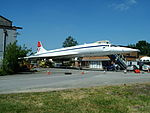St George's Hill

St George's Hill is a 964-acre (3.9 km2) private gated community in Weybridge, Surrey, United Kingdom. The estate has golf and tennis clubs, as well as approximately 420 houses. Land ownership is divided between homes with gardens, belonging to home owners, and the estate roads and verges belonging to its residents' association. The hill first served as a home and leisure location to celebrities and successful entrepreneurs on its division into lots in the 1910s and 1920s when Walter George Tarrant built its first homes. In a survey, most roads in the estate showed an average house sale price of over £5,500,000, with many properties selling for in excess of £15m and a handful selling for between £20m & £30m, meaning it is one of the most expensive and exclusive places to live in the UK and worldwide.
Excerpt from the Wikipedia article St George's Hill (License: CC BY-SA 3.0, Authors, Images).St George's Hill
Linden Road, Elmbridge
Geographical coordinates (GPS) Address Nearby Places Show on map
Geographical coordinates (GPS)
| Latitude | Longitude |
|---|---|
| N 51.352 ° | E -0.445 ° |
Address
Linden Road
Linden Road
KT13 0QW Elmbridge
England, United Kingdom
Open on Google Maps









